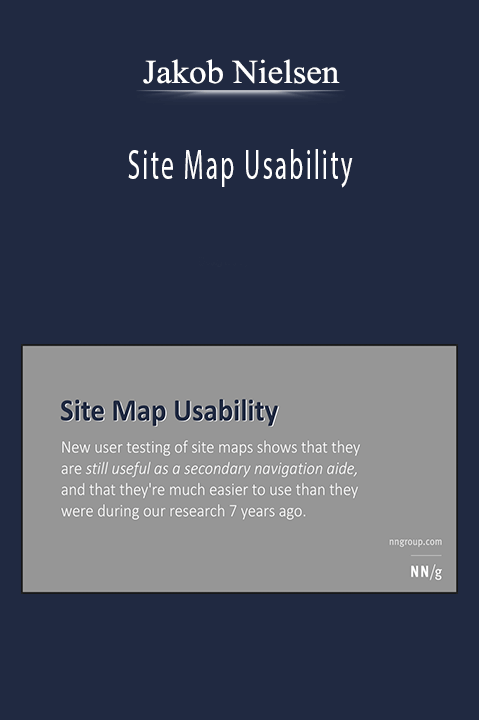Jakob Nielsen – E-commerce User Experience
207 Guidelines for E-commerce Sites
389 page book collecting all nine reports
Summary
The reports contain extensive guidelines for how to design e-commerce sites to make them more usable. All guidelines are based on findings from detailed usability studies of twenty e-commerce sites with users in the United States and Europe.
See the descriptions for the individual reports below for more information.
Richly illustrated with 221 color screenshots of designs that worked particularly well or that caused problems for shoppers.
Individual Reports
Executive Summary
This report distills the data from our major international usability study into the essence of e-commerce, discussing the strategic implications of our findings for the future of e-commerce. This is the report to give to your boss if he or she doesn’t have time to read the detailed reports.
Category Pages
Category pages organize and prioritize a site’s offerings. Home pages are one type of category page. Some home pages clearly show what the site sells, but others confuse users by obscuring the purpose of the site. Product listing pages can be tricky to design because they must provide the right amount of information, and organize it well. 28 design guidelines.
Product Pages
Users need sufficient information about a product before purchasing it online. Product pages provide that information using a combination of text and images. Effective product pages show availability, product options, and total cost. Good images also matter. 30 design guidelines.
Shopping Carts, Checkout & Registration
Filling out forms correctly during shopping is very difficult for most users. Forcing people to register during their first purchase is a confusing and frustrating tactic that drives customers away. Better designs mean more customers can complete the shopping process. 32 design guidelines.
Search
Many of our users went right to the site’s search tool (unless it was hidden) but there were several reasons search didn’t always help them. How to improve search results and search pages in product catalogs. 29 design guidelines.
Selling Strategies
Some sites drive their customers away with high prices, unreasonable shipping costs, or unavailable items. Sites that learn to avoid these problems can then focus on tactics for achieving additional sales through cross-selling, recommendations, and gift-giving. 47 design guidelines.
Trust and Credibility
Trust is the user’s willingness to risk time, money, and personal data on a website. This report discusses many factors that can enhance (or damage) an e-commerce site’s credibility. 34 design guidelines.
International Users
When US-based sites go global, many aspects of the user experience get broken. This report focuses on not only the obvious issues such as address formats, but also cultural issues as well. Based on usability tests of European users. 19 design guidelines.
Methodology
This report details how we conducted this study, including a summary of user demographics, how we briefed and interacted with users, and a summary of all the tasks. No design guidelines, but plenty of advice for running your own tests.
Note: If you add up the number of guidelines in the individual reports then the result is more than 207. However, this is the true total since some of the guidelines are discussed in more than one report.
How Can We Sell These Reports So Cheaply?
Everybody we have talked with recommended charging a thousand dollars for each of the E-Commerce User Experience reports. First, this is the price that traditional “analyst companies” charge for their reports, and second, any e-commerce site would gain many times more in increased sales from even the smallest improvement in usability. If there is even a single one of our guidelines that a site has overlooked in its design, it would make several thousand dollars from following that one bit of advice.
We have defied our advisors and stuck to a low price for several reasons:
- On the Internet, the economics of intellectual property change: since there are almost no distribution costs (and no sales costs except this website), it makes more sense to aim to sell a large number of copies at a low price than a small number of copies at a high price (as one would do in the traditional world of high expenses for sales and distribution).
- We want to reach a large number of readers: we are fed up with the poor state of Web usability.
- Our data shows that smaller e-commerce sites are the ones in most desperate need of usability improvements, so we wanted to make sure that even the smallest site could afford the reports.
- Finally, it is an experiment for us to publish a report through the Internet, so we wanted to make the entire project as net-centric as possible. Ideally, we would have used micropayments to allow readers to buy a single design guideline for a dollar. That must wait for a later report.
Get Download Jakob Nielsen – E-commerce User Experience at Offimc.click Now!
Archive: https://web.archive.org/web/20070701013920/http://www.nngroup.com/reports/ecommerce/
Delivery Information
- Upon ordering the product, a delivery email with download instructions will be sent immediately to you so that you may download your files. If you log in (or create an account) prior to purchase you will also be able to access your downloads from your account dashboard.
- It is a digital download, so please download the order items and save them to your hard drive. In case the link is broken for any reason, please contact us and we will resend the new download link to you.
- If you don't receive the download link, please don’t worry about that. We will update and notify you as soon as possible from 8:00 AM – 8:00 PM (UTC+8).
- Please Contact Us if there are any further questions or concerns you may have. We are always happy to assist!












8 reviews for E–commerce User Experience – Jakob Nielsen
There are no reviews yet.